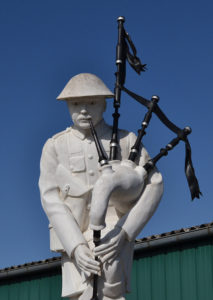A WW1 article in the Scotsman at the weekend made poignant reading – five hundred pipers killed and six hundred wounded. It read:
‘London-born Sir Philip Gibbs (1877-1962), one of five official reporters during the First World War, wrote about the effects of the pipes and the extraordinary bravery of pipers and Highlanders among the British forces at the Battle of Delville Wood near the village of Longueval which raged from 15 July to 3 September 1916.
During the Great War 100 battalions had more than 2,500 pipers with them. Of these, 500 pipers were killed and 600 wounded. Gibbs’ searing account of warfare led to him being ordered to return home as the War Office attempted to ‘manage’ information about the war. Writing about the Battle of Delville Wood, Gibbs noted: ‘It was to the tune of the The Campbells Are Coming that one regiment went forward… heard with terror, beyond a doubt, by the German soldiers.
‘Then the pipes screamed [sic] out the Charge, the most awful music to be heard by men who have the Highlanders against them, and with fixed bayonets and hand-grenades they stormed the German trenches.’
‘He described regiments marching out of the war zone ‘their kilts caked in mud and stained with blood and filth’, and how ‘they brought their music with them, and the pipes of war were playing a Scottish love song, I Love Nae Laddie But Ain.

‘Dr Yvonne McEwen, director of Scotland’s War 1914-1919, at the University of Edinburgh, said the Germans were acutely aware of the power the pipers had to motivate Scottish troops and that research has shown music was also highly therapeutic in the war. In 2002 a memorial was unveiled in Longueval to pipers killed in the Great War.’
Read the full article here. Incidentally there was a very good documentary on the Scotsman newspaper on the BBC last week which may still be available on catch-up. It revealed that its paper sale was down to a dreadful 20,000 a day, only a fifth of what it was 20 years ago. Worrying, and something that is being reflected throughout the print media as more and more people turn to the web for their news. However I am sure the Scotsman will survive and with interesting articles such as the one highlighted today will continue to be read both in hard copy and online.
The famous picture up top is from the Imperial War Museum and shows a piper of the 7th Seaforth Highlanders cheering up his comrades with a tune after Longueval. Read more on pipers in WW1 here.
 Reader Vincent Janowski has sent a letter on the CITES blackwood legislation and how an article he wrote for the Voice magazine back in 2007 explained how its controlled harvesting was inevitable. There’s a link to the article in Vincent’s letter which can be read here.
Reader Vincent Janowski has sent a letter on the CITES blackwood legislation and how an article he wrote for the Voice magazine back in 2007 explained how its controlled harvesting was inevitable. There’s a link to the article in Vincent’s letter which can be read here.
Still on this issue, the Music Industries Association’s Chief Executive Paul McManus reports on their website that small instrument making firms are being threatened with closure as a result of the new legislation and also that a ban is looming on the sale of ALL instruments made after 1947 which contain ivory.
In practice this would mean that second-hand pipes of that vintage could no longer be bought and sold so if you have such a set and are thinking of disposing of it then best get a move on.
Mr McManus: ‘I attended the CITES user group meeting last Thursday in Bristol to press the case on behalf of our industry in relation to the new and looming new restrictions …… The Association of British Orchestras were also there to fly the flag with me for instruments and musicians. It was very evident that all the government officials are well-intended but totally struggling with the workload and management of the CITES legislation. Lack of staffing was mentioned more than once and the associated worries about processing paperwork and licenses.
‘Having said that, the case for our industry was well received and I was given a good chance to let them know the problems we are trying to overcome in order to comply with the huge raft of paperwork and on-cost associated with all of this. I specifically made the point that the new wood restrictions are actually threatening to put some of our small companies out of business where cost compliance is not viable in relation to the selling costs of the instruments.
‘They had no idea how many small luthiers (instrument makers) we had in the UK who are faced with enormous cash flow challenges and uncertainty whilst the government and the EU sort out the implementation of the new rosewood [includes African blackwood] restrictions. On that note, we still do not expect the EU, and therefore the UK, to be ready to issue licenses etc. until ‘early February’ which I made clear was literally putting some of our members in jeopardy. I made the point that the license charging system will be prohibitive to the smaller businesses in the UK and pressed for some sort of assistance when the tiny amounts of restricted woods and low product selling price made license compliance untenable.
‘As you may be aware, there is legislation looming that may totally prohibit the selling of ivory made after 1947 though the Government are yet to work out how to date ivory. An open consultation will take place on the matter in the next few weeks and final decisions will be made after that.’
Pipemakers wishing to have their interests properly represented can join the Music Industries Association here. APHA in Bristol confirmed to me last week that UK pipemakers shipping instruments to the US and to other ex-EU countries should submit their licence applications right away in anticipation of the EU green light early to mid-February.

















Gosh the ivory situation is serious.. I have several sets of pipes all mounted in bits with ivory. I have the belief that they were made a good while before 1947, otherwise I would not have them. I will not be alone in this. Dating ivory as has been mentioned would be difficult and maybe expensive. Surely the alternative of re-mounting the pipes with imitation ivory is not one to be considered in the event of selling a bagpipe made post 1947?. It would do not do any good for conservation.
Is thereasy a method for dating ivory, whether elephant or walrus, which is easily done?
Buying or selling will be the criteria. There will be some people who will benefit from the recieving of gifted pipes with post 1947 ivory.
The South African Scottish (later named Transvaal Scottish) were in action at Delville Wood with their pipers. The SA Scottish were given a commemorative Delville wood cross as a reuslt of their heavy losses which was made from the trees of the wood and is in “The View” to this day.